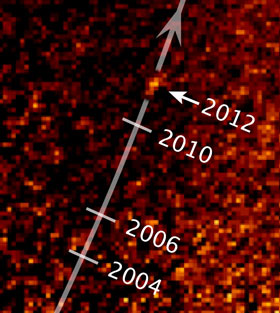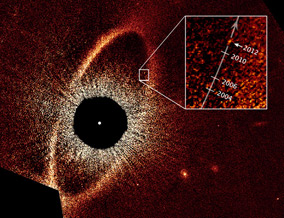Sauron’s Got Some ‘Splainin to Do
The mystery deepens: What the heck is orbiting the star Fomalhaut?
In 2008, astronomers using Hubble Space Telescope announced they had found a planet orbiting the young nearby star Fomalhaut, located a mere 25 light years away. In fact, it was one of the very first alien planets ever directly imaged [that link goes to a very cool gallery of all the exoplanets directly seen so far]. The star is surrounded by a vast ring of dust, making it look like the Eye of Sauron from the Lord of the Rings movies, and there was a lot of circumstantial evidence the ring was being influenced by a planet. In the Hubble images, there was a blob of light that had moved over the course of 2004 to 2006, pretty much as you’d expect a planet located there to move.
Then trouble set in. Some astronomers claimed it wasn’t a planet because they couldn’t detect it in infrared light, where it should glow brightly. They also said the orbit of the planet crossed the ring, which would disrupt the ring given enough time. The planet’s existence was thrown in doubt.
But then more drama: The original astronomers realized it’s possible the planet was enshrouded in dust, which would absorb the planet’s intrinsic infrared light, but still reflect enough starlight from Fomalhaut to be visible to Hubble. If it were a gas giant with the mass of Saturn or so, it would be able to hold on to a cloud of dust and yet not be bright enough to see in the infrared. They also found with follow-up observations that the orbit of the object didn’t cross the ring, so the ring’s gravitational disruption wasn’t a problem.
So where do we stand now? Last year, more observations were taken, and were just released. They clearly show the blob has moved again, and the movement is consistent with the orbit of, well, something, including a planet. But the orbit is really weird: It’s highly elliptical, taking the planet (if that’s what it is) as close to the star as 7 billion kilometers, and as far out as 45 billion km. Mind you, that puts the inner part of its orbit farther out than Neptune orbits the Sun!

Image credit (for both): NASA, ESA, and P. Kalas (University of California, Berkeley and SETI Institute)
But then it gets weirder. These new images make it more difficult to say if the object misses the ring or not. The orbit might cross the ring, or it may be inclined to the ring plane and therefore miss it entirely. If the latter, though, that would explain why the ring has survived so long.
It’s difficult to form a planet on an orbit like that. It’s far more likely that the planet formed much closer in to the star, and a more massive planet kicked it out into the depths of space after a close encounter. That happens pretty often in young solar systems like Fomalhaut. We don’t know of any more planets in the system, but they would be too close in to have been spotted yet against the fierce light from Fomalhaut.
The orbit may also explain the peculiar invisibility of the object in infrared. If it has moons (and most large planets should) they may get bombarded by impacts when the object swings into the inner part of its orbit every 2000 years. This would create a cloud of dust that could stay in the system for millennia, which is what the astronomers thought might be the case.
Interestingly, the ring around the star is thicker than expected and has features in it (like a gap) that imply there’s yet another planet out there, carving the ring up. If so, it too may have been tossed out there by an encounter in the inner system.
Now let me be clear: This is all still pretty much speculation, and it’s not at all certain what’s going on here. I know of a few astronomers who still doubt this is a planet, and that’s a fair stance. All we have are these four observations from Hubble, and a peculiar absence of the object in infrared observations. I’m uncomfortable with all the assumptions needed for it to be a planet, but the evidence it’s not a planet isn’t iron-clad either. The Hubble pictures do show something is there, but whether it’s a planet or not is yet to be seen.
But there’s a trump card yet to be played. If the object’s orbit does in fact cross the ring, then it will smack into countless particles as it does so. If it’s a planet, this should make it brighter in the infrared (impacts tend to, ah, generate a lot of heat). If that happens, it’ll be in about 20 years…when the James Webb Space Telescope should still be in operation. This is a massive infrared telescope, the successor to Hubble. I suspect it (or other sensitive telescopes like it) would be able to spot the glow of these collisions should they occur. Either way, it would probably settle the case.
Until then, though, the only option is to continue to observe this fascinating star and its retinue of weird orbiting objects. It’s funny. This is one of the closest and brightest stars in the sky, and should be far easier to study, but instead it’s created an interstellar mystery that may yet take us decades to resolve. Hopefully it’ll be sooner than that though!



